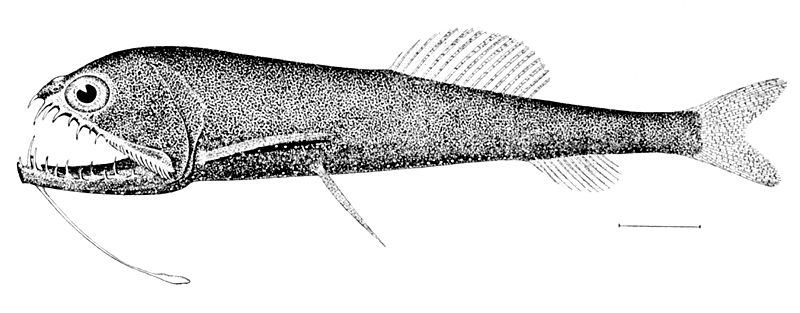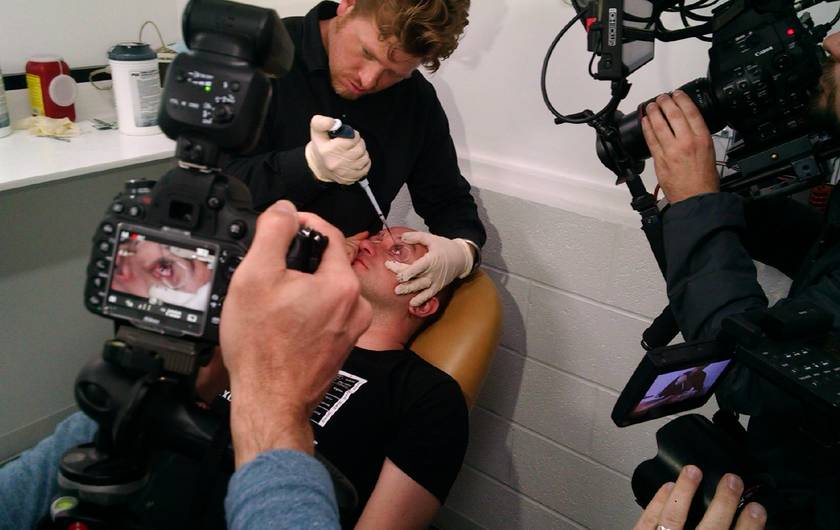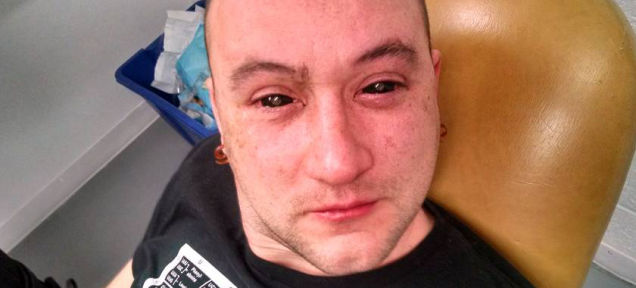When I called up the Columbia scientist whose mouse experiments inspired two biohackers to squirt chemicals in their eyes to induce “night vision”, I expected, at best, cautious optimism. I did not expect him to tell me that, oh yeah, once, in his younger days, he hooked himself up to an IV and tried it, too.
In case you missed it, the internet exploded last week when a pair of biohackers with the group Science for the Masses shared a report about night vision. Eyedrops with a chlorophyll analogue called chlorin e6 seemed, they said, to induce temporary night vision. They had some creeptastic scifi-looking photos to boot.
Gabriel Licina, the guy who risked his eyes, and his co-conspirator Jeffrey Tibbetts, looked a lot more normal when I Skyped them this week, though they did have the slightly dazed expressions of people overwhelmed by the internet’s limelight. Licina has done research in a university lab, and Tibbetts is a registered nurse. They aren’t lone geniuses who’ve invented crazy new science, but they aren’t total naifs stumbling around blindly.
Still, it seems weird that anyone would feel compelled to dribble an untested substance into his eyes — but it’s hardly the only thing weird about this story.
Licina and Tibbetts had been doing a long-term study using vitamin A2 to extend human vision into the infrared when they heard about chlorin e6. (For what it’s worth, they claim to have promising data on vitamin A2, though scientists are understandably sceptical.) The chlorin e6 experiment is largely based on a 2012 patent filed by Totada R. Shantha, a Georgia doctor who lost his licence for medical fraud in 2008 and now appears to be filing patents by the dozen. Licinia and Tibbetts told me they did attempt to contact Shantha, who never replied. It seems odd to never at least acknowledge the shady source of the patent, but to hear the pair tell it, they never expected their experiment to be the subject of mass dissemination and dissection; they were simply writing a report for a group of likeminded hackers.
Buried in that sketchy patent, though, is a reference to a 2007 paper by Ilyas Washington, now an assistant professor of ophthalmology at Columbia. Single papers are never conclusive, but the study’s experiments in mice are solidly executed. For the past ten years, Washington has wanted to run human trials to follow up that paper — that was until a couple of biohackers in California kind of scooped him. “It’s something that my group has been planning, and we just haven’t gotten back to it,” he said.
A Plausible Scientific Explanation?
It begins with the dragonfish. A decade ago, Washington came across old reports noting a strange thing about the eyes of these bioluminescent deep-sea creatures.

A deep-sea dragonfish. Oceanic Ichthyology
The cells in our eyes detect dim light with a light-sensitive protein called rhodopsin, and rhodopsin is most sensitive to green light. In the deep-sea dragonfish, though, their rhodopsins were responding to red light. There was a second odd observation: Their eyes contained a chlorophyll derivative that also absorbed red light, suggesting that perhaps this chlorophyll derivative was attaching to the rhodopsin to make it sensitive to red.
In 2006, Washington published a paper attempting to recreate this biochemistry in mice. He injected a chlorophyll derivative called chlorin e6, which is used to treat cancer, into a handful of mice. Indeed, the mice ended up being more sensitive to red light and red light alone, based on electrical recordings from their retinas. He also dissected their eyeballs to make sure the chlorin was actually in retinal cells. His paper is published, but like most papers, it’s only by read a handful of other researchers.
Nearly a decade later, Licina and Tibbetts came across the patent that cited Washington’s paper. They decide to try it out because, why the heck not? They eventually formulate a chlorin e6 solution for human use. A few drops are dripped into Licina’s eyes, and they had him look for people hidden among trees as well as symbols on objects in dim light. Licina seemed to perform a lot better than the four other people who did not get eyedrops.
Interesting! But is this night vision?
The Problems With the Night Vision Eye Drop Experiment

In Licina’s own words: “Let’s be fair here. It’s kind of crap science.” Here is why their experiment is intriguing but far from conclusive.
Baseline testing — There’s natural variation in human vision, and we all see things a little differently. It’s possible Licina might have naturally better vision in dim light than others. Without testing him and the others both before and after the treatment, there’s no way to show it’s the eyedrops that made a difference.
Placebo effect — Scientists have also had to learn the hard way that expectations shape our reality. True, a placebo eyedrop is not going to make you actually see things that you physically cannot see, but it can make you more confident in believing you’re seeing. In an experiment that relies on you interpreting fuzzy shapes in the dark, willingness to rely on the gut can make a difference.
Can chlorin e6 even reach the retina? — In Washington’s experiment, he actually injected chlorin e6 directly into the bloodstream. In Licina’s case, the solution was dropped onto the inside of his eyelid, where it would have to diffuse to the back of his eyeball and go through layers of cells to reach the retina. Washington said whether chlorin e6 can effectively reach the retina through this route is unknown. James Ver Hoeve, a scientist with University of Wisconsin’s ophthalmology department put it more bluntly in an email: “administering drops is not a particularly effective way to get drugs to the retina.”
Safety — We only have two eyeballs, and chlorin e6 is not a benign substance. Its current use is in cancer treatment, where it kills cells once activated by light. To hear Licina and Tibbett tell it, they scoured the literature to come up with a safe dosage. The creepy photo you see of Licina’s black eyes is actually black sclera lenses protecting his eyes from light. Still, Licina and Tibbett ventured deep into the unknown here, and things can always go wrong.
So, uh, now what?
Licina and Tibbetts know exactly what their next step is: an electroretinogram, or ERG. It’s a technique, commonly performed by eye doctors, that involves hooking up electrodes to the cornea and skin around the eye to measure the activation of light-sensitive cells in the retina. The test gets rid of the subjectivity inherent in the question “can you really see.”
When they do, it won’t be the first time someone has used the test to assess the effects of chlorine e6. After Washington performed his experiments in mice — which also involved ERGs, but for mice — he tried it on himself. He hooked himself up to an IV with chlorine e6 and recorded his own ERG data. It appeared to work — though it, too, was a small and not particularly rigorous study. “I’ve done silly things like that, eight years ago when I was younger,” Washington said, with laugh.
Since then, Washington has published a lot of other research — some that goes toward curing blindness. In other words: research that is easy to explain to funding agencies. The National Institutes of Health is not in the business of enhancing night vision; it is in the business of finding cures for things like blindness. The night vision stuff has been shuffling along, mostly as a side project all these years.
“You don’t want to say something that would encourage and endanger anyone. That’s my major concern,” said Washington. But, like any scientist, he’s pleased someone else out there cares about his research. Washington first heard about Science for the Masses’ experiment when journalists began emailing him about it. It was bizarre to me that Tibbetts and Licina hadn’t contacted him at all, but perhaps that speaks to a wall between professional science and DIY science — one that maybe shouldn’t be so impermeable.
Pictures: Gabriel Licina
